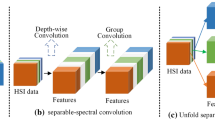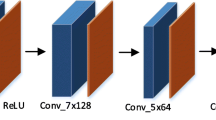Abstract
Hyperspectral images (HSIs) are often contaminated by noises due to the multi-detector imaging systems, which greatly affects the subsequent HSIs interpretation and application. The 3D HSIs deliver extra spectral information, which makes the most existing destriping algorithms hardly satisfied, and the complete stripes removal and less test time consuming remain to be overcome. To meet these challenges, we present a multi-scale dilated unidirectional convolution network (MsDUC) with the following contributions. First, the deep learning-based method can fully exploit and preserve spatial-spectral correlations in 3D HSIs while the conventional methods failed to realize it. Second, different dilated convolution learns different scale features, so the introduced multi-scale dilated convolution could get more contextual information for the final restoration. Third, the clear directional signature of stripe noise and the unidirectional total variation (UTV) model inspired us to put forward the unidirectional convolution to capture the directional signature of stripe, meanwhile, the less trainable parameters and the utilized residual strategy speed up the learning process. Experimental results have shown that our method outperforms many of the state-of-the-art methods in both image restoration performance and test running time. Our code can be download from https://github.com/doctorwgd/MsDUC.









Similar content being viewed by others
References
Acito N, Diani M, Corsini G (2011) Subspace-based striping noise reduction in hyperspectral images. IEEE Trans Geosci Remote Sens 49(4):1325–1342
Arad B, Ben-Shahar O (2016) Sparse recovery of hyperspectral signal from natural rgb images, European Conference on Computer Vision (ECCV), 19–34.
Bouali M, Ladjal S (2011) Toward optimal destriping of MODIS data using a unidirectional variational model. IEEE Trans Geosci Remote Sens 49(8):2924–2935
Cai W, Wei Z (2020) PiiGAN: generative adversarial networks for pluralistic image Inpainting. IEEE Access 8:48451–48463
Carfantan H, Idier J (2010) Statistical linear destriping of satellite-based pushbroom-type images. IEEE Trans Geosci Remote Sens 48(4):1860–1871
Chang Y, Yan L, Fang H, Liu H (2014) Simultaneous destriping and denoising for remote sensing images with unidirectional total variation and sparse representation. IEEE Geosci Remote Sens Lett 11(6):1051–1055
Chang Y, Yan L, Fang H et al (2015) Anisotropic spectral-spatial total variation model for multispectral remote sensing image destriping. IEEE Trans Image Process 24(6):1852–1866
Chang Y, Yan L, Fang H, Zhong S, Liao W (2019) HSI-DeNet: Hyperspectral image restoration via convolutional neural network. IEEE Trans Geosci Remote Sens 57(2):667–682
Chen C, Li S, Wang Y, Qin H, Hao A (2017) Video saliency detection via spatial-temporal fusion and low-rank coherency diffusion. IEEE Trans Image Process 26(7):3156–3170
Datt B, McVicar TR, Van Niel TG et al (2003) Preprocessing EO-1 Hyperion hyperspectral data to support the application of agricultural indexes. IEEE Trans Geosci Remote Sens 41(6):1246–1259
Fan D, Wang W, Cheng M et al Shifting more attention to video salient object detection. IEEE Conf Comput Vis Pattern Recognit (CVPR). https://doi.org/10.1109/CVPR.2019.00875
Freiberger M, Clason C, Scharfetter H (2010) Total variation regularization for nonlinear fluorescence tomography with an augmented Lagrangian splitting approach. Appl Opt 49(19):3741–3747
Gadallah F, Csillag F, Smith E (2000) Destriping multisensor imagery with moment matching. Int J Remote Sens 21(12):2505–2511
He K, Zhang X, Ren S et al (2016) Deep residual learning for image recognition. IEEE Conf Comput Vis Pattern Recognit (CVPR) 770–778:2016
Hu S, Wang G, Wang Y, Chen C, Pan Z (2020) Accurate image super-resolution using dense connections and dimension reduction network. Multimed Tools Appl 79:1427–1443
Kautsky J, Nichols N, Jupp D (1984) Smoothed histogram modification for image processing. Comput Vis Graph Image Process 26(3):271–291
Kim J, Lee JK, Lee KM (2016) Accurate image super-resolution using very deep convolutional networks. IEEE Conf Comput Vis Pattern Recognit (CVPR) 1646–1654. https://doi.org/10.1109/CVPR.2016.182
Kingma DP, Ba J (2015) Adam: a method for stochastic optimization, International Conference for Learning Representations (ICLR).
Krizhevsky A, Sutskever I, Hinton GE (2012) Imagenet classification with deep convolutional neural networks. Adv Neural Inf Process Syst (NIPS) 25(2):1097–1105
Liu X, Lu X, Shen H, Yuan Q, Jiao Y, Zhang L (2016) Stripe noise separation and removal in remote sensing images by consideration of the global sparsity and local variational properties. IEEE Trans Geosci Remote Sens 54(5):3049–3060
Liu X, Shen H, Yuan Q, Lu X, Zhou C (2018) A universal Destriping framework combining 1-D and 2-D Variational optimization methods. IEEE Trans Geosci Remote Sens 56(2):808–822
Liu X, Shen H, Yuan Q et al. (2016) A novel removal method for dense stripes in remote sensing images. ISPRS Ann Photogramm Remote Sens Spatial Inf Sci III-6:57–61
Lu X, Ma C, Ni B, et al. (2018) Deep regression tracking with shrinkage loss, European Conference on Computer Vision (ECCV), 353–369.
Lu X, Wang W, Ma C, et al (2019) See more, know more: unsupervised video object segmentation with co-attention siamese networks, IEEE Conference on Computer Vision and Pattern Recognition (CVPR).
Manolakis D, Shaw GS (2002) Detection algorithms for hyperspectral imaging applications. IEEE Signal Process Mag 19(1):29–43
Munch B, Trtik P, Marone F et al (2009) Stripe and ring artifact removal with combined wavelet-Fourier filtering. Opt Express 17(10):8567–8591
Pande-Chhetri R, Abd-Elrahman A (2011) De-striping hyperspectral imagery using wavelet transform and adaptive frequency domain filtering. ISPRS J Photogramm Remote Sens 66(5):620–636
Rakwatin P, Takeuchi W, Yasuoka Y (2007) Stripe noise reduction in MODIS data by combining histogram matching with facet filter. IEEE Trans Geosci Remote Sens 45(6):1844–1856
Romero A, Gatta C, Camps-Valls G (2016) Unsupervised deep feature extraction for remote sensing image classification. IEEE Trans Geosci Remote Sens 54(3):1349–1362
Roth S., Black M. J. (2005) Fields of experts: a framework for learning image priors, IEEE Conference on Computer Vision and Pattern Recognition (CVPR), pp. 860-867.
Rudin LI, Osher S, Fatemi E (1992) Nonlinear total variation based noise removal algorithms. Physica D: Nonlinear Phenomena 60(1–4):259–268
Shen H, Zhang L (2009) A MAP-based algorithm for destriping and inpainting of remotely sensed images. IEEE Trans Geosci Remote Sens 47(5):1492–1502
Shi W, Jiang F, Zhao D (2017) Single image super-resolution with dilated convolution based multi-scale information learning inception module, IEEE International Conference on Image Processing (ICIP), 977-981.
Simonyan K, Zisserman A (2015) Very deep convolutional networks for large-scale image recognition, International Conference on Learning Representations (ICLR).
Tarabalka Y, Chanussot J, Benediktsson JA (2010) Segmentation and classification of hyperspectral images using minimum spanning forest grown from automatically selected markers. IEEE Trans Syst Man Cybern B 40(5):1267–1279
Torres J, Infante S (2001) Wavelet analysis for elimination of striping noise in satellite images. Opt Eng 40(7):1309–1314
Torres J, Infante S (2001) Wavelet analysis for elimination of striping noise staellite images. Opt Eng 40(7):1309–1314
Wang Z, Bovik AC, Sheikh HR, Simoncelli EP (2004) Image quality assessment: from error visibility to structural similarity. IEEE Trans Image Process 13(4):600–612
Wang Y, Wang G, Chen C, Pan Z (2019) Multi-scale convolution of convolutional neural network for image denoising. Multimed Tools Appl 78:19945–19960
Wang W, Lu X, Shen J., et al. (2019) Zero-shot video object segmentation via attentive graph neural networks, IEEE International Conference on Computer Vision (ICCV).
Wang Y, Hu S, Wang G et al (2020) Multi-scale dilated convolution of convolutional neural network for crowd counting. Multimed Tools Appl 78(11):1057–1073
Wei Y, Yuan Q, Shen H et al (2017) Boosting the accuracy of multispectral image pansharpening by learning a deep residual network. IEEE Geosci Remote Sens Lett PP(99):1–5
Xiao P, Guo Y, Zhuang P (2018) Removing stripe noise from infrared cloud images via deep convolutional networks. IEEE Photonics J 10(4):1–14
Yan L, Fang H, Zhong S (2012) Blind image deconvolution with spatially adaptive total variation regularization. Opt Lett 37(14):2778–2780
Yasuma F, Mitsunaga T, Iso D, Nayar SK (2010) Generalized assorted pixel camera: Postcapture control of resolution, dynamic range, and Spectrum. IEEE Trans Image Process 19(9):2241–2253
You H, Tian S, Yu L, Lv Y (2020) Pixel-level remote sensing image recognition based on bidirectional word vectors. IEEE Trans Geosci Remote Sens 58(2):1281–1293
Yu F, Koltun V (2016) Multi-scale context aggregation by dilated convolutions, International Conference on Learning Representations (ICLR).
Zhang K, Zuo W, Chen Y, Meng D, Zhang L (2017) Beyond a Gaussian denoiser: residual learning of deep cnn for image denoising. IEEE Trans Image Process 26(7):3142–3155
Zhao J, Liu J, Fan D, et al. (2019) EGNet: edge guidance network for salient object detection, IEEE International Conference on Computer Vision (ICCV).
Acknowledgements
This work was supported by the Natural Science Foundation of Shandong Province (No. ZR2019MF050) and "Taishan Scholar" Project of Shandong Province.
Author information
Authors and Affiliations
Corresponding author
Additional information
Publisher’s note
Springer Nature remains neutral with regard to jurisdictional claims in published maps and institutional affiliations.
Rights and permissions
About this article
Cite this article
Wang, Z., Wang, G., Pan, Z. et al. Fast stripe noise removal from hyperspectral image via multi-scale dilated unidirectional convolution. Multimed Tools Appl 79, 23007–23022 (2020). https://doi.org/10.1007/s11042-020-09065-4
Received:
Revised:
Accepted:
Published:
Issue Date:
DOI: https://doi.org/10.1007/s11042-020-09065-4




